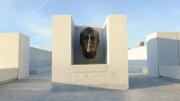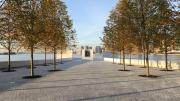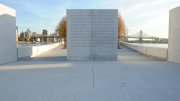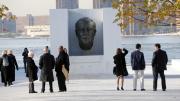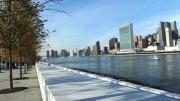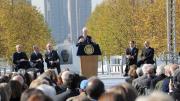In 1972, Welfare Island in the East River was renamed Roosevelt Island; a year later, renowned architect Louis I. Kahn was charged with designing a park in honor of President Franklin Delano Roosevelt, A.B. ’04, LL.D. ’29, a commission he completed just before his sudden death in 1974. Almost 40 years later, a star-studded cast—including former president Bill Clinton, New York City mayor Michael Bloomberg, Tom Brokaw, singer Audra McDonald, the West Point Band, and Staten Island’s Public School 22 Chorus—gathered on the island on October 17 to officially open the Franklin D. Roosevelt Four Freedoms Park.
The first and only memorial dedicated to President Roosevelt in his home state of New York, the park is named after FDR’s 1941 State of the Union Address (also known as the Four Freedoms Speech), in which he said the way to justify the enormous sacrifice of war was to create a world centered on four essential human freedoms—freedom of speech and expression; freedom of worship; freedom from want; and freedom from fear.
In a press release, former U.S. ambassador to the UN William vanden Heuvel, chairman of the Franklin D. Roosevelt Four Freedoms Park Conservancy said, “We hope visitors of different ages will understand that the four freedoms are the core values of democracy and that each generation has to be sure to protect them.”
The park consists of a four-acre, triangular expanse of green, lined by 120 littleleaf linden trees leading to an enlarged version of the famous bronze bust of Roosevelt (created by American sculptor Jo Davidson) at the threshold of a square, white-granite, open-air plaza. It affords views across the East River to the United Nations, 300 yards away, an institution for which Roosevelt laid much of the groundwork. New York Times architecture critic Michael Kimmelman said the park “gives New York nothing less than a new spiritual heart.”
The park’s long-delayed completion and opening had most recently been held up by a legal dispute with two major donors over how prominently their names would be displayed at the site, according to the Huffington Post: the Alphawood Foundation donated $10.8 million and reached an undisclosed settlement, while the Reed Foundation donated $2.9 million and won a court judgment for its name to be engraved in an area near the memorial bust as spelled out in a contract. The park had argued that “such a placement would dishonor a great president and defile Kahn’s great work,” according to an earlier article in the Times.
In the next several years, the park’s administrators plan to transform a nearby, abandoned, nineteenth-century smallpox hospital into a visitors' center, and plans to work closely with Cornell, which is planning a graduate center on the island, on a nearby dock to transport people to the site via water taxi and ferry.
A 1996 Harvard Magazine cover story, “Frank Roosevelt at Harvard,” pointed out that FDR cherished his Harvard connections and was a “remarkably loyal” alumnus who regularly attended Harvard Club dinners in New York, Boston, and Washington and, until he was stricken with polio, rarely missed a Harvard-Yale football game. He returned for reunions, and for Fly Club and Crimson dinners. In 1917 he was elected to the Board of Overseers. And yet for decades, “no lasting memorial to Franklin Delano Roosevelt was ever established at Harvard”—“no Franklin D. Roosevelt Center, no Roosevelt chair of political science, no Roosevelt lectureships, scholarships, or fellowships [to] memorialize the most famous American of his time, a man who overcame severe physical disability and led his nation and its allies through the most desperate days of the twentieth century”—until in 2008, Adams House began a continuing effort to restore the Westmorly Court rooms where FDR lived as an undergraduate.
The Four Freedoms Park, itself more than 40 years in the making, is further evidence that such omissions can be redressed, even many decades later.
